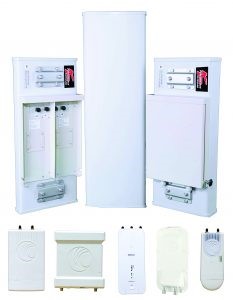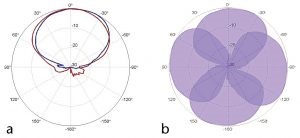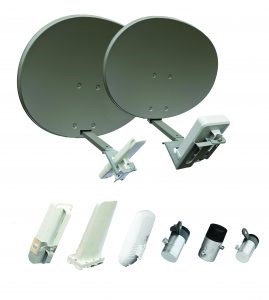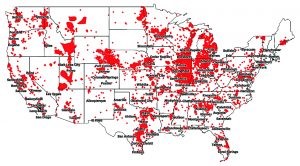New Antennas Meet the Expanding Needs of the WISP Market
Originally Published for Microwave Product Digest
Wireless Internet Service Providers (WISPs) have kept pace with technology from their roots as “mom-and-pop shops” to formidable service providers using technologies ranging from MIMO to LTE with performance competitive with cable and Fiber to the Home (FttH). Although often overshadowed by “flashier” technologies, antennas for WISP continue to advance in their capabilities. KP Performance Antennas, now part of Alive Telecom, has introduced new reflector and dual-frequency sector antennas designed to meet the needs of the latest WISP networks.
Figure 1: The Model KPPA-2SV5HV-90SS incorporates radios and antennas for both 2 and 5 GHz, reducing tower leasing costs and wind loading
KP Performance Antennas has been manufacturing antennas and related components for the WISP market and other applications since it was founded in 2008 by former owners of WISP networks whose experience dates to the market’s first days. Its products include sector, reflector, directional, grid, and panel antenna types, each fulfilling a specific requirement. The product line covers all frequencies used by WISPs, including 900 MHz, 2.4 GHz, 3 GHz, and 5 GHz. The products are supported by feedhorns, mounting equipment, and most recently, radios from Cambium and Baicells.
The company’s latest generation of dual-frequency panel (sector) antennas, when combined with a WISP radio provide coverage in both 2 GHz and 5 GHz in a single radome. These dual-frequency solutions are increasingly popular as tower owners charge by the antenna, so dual-frequency installations that provide two radio-antenna combinations in the space typically occupied by one can reduce costs by half. The Model KPPA-2S5HV-90SS, for example (Figure 1), has azimuth beamwidth of 90 deg. at both frequencies and elevation beamwidth of 7.2 and 4.9 deg. at 2300 to 2700 MHz and 5200 to 5900 MHz, respectively, with gain of 15.1 and 15.9 dBi.
Mounting cases and Type-N female connectors accommodate two Cambium ePMP radios. The KPPA-2S5HV-90SS measures only 28.5 x 8.5 x 4.5 in. and weighs 8.5 lb. Other versions include 2, 3, and 5 GHz single-band, dual-sector antennas; 2 and 3 GHz or 3 and 5 GHz sector antennas; and 2, 3, and 5 GHz single-band, quad-polarization sector antennas. The pattern for a single KPPA-2S5HV-90SS at both frequencies is shown in Figure 2a. Four systems mounted around the tower provide full 360-deg. coverage (Figure 2b).
The new reflector antennas are designed for installation at the subscriber location. They can be combined with radios from Cambium, Mimosa, and Ubiquiti Networks, or feedhorns. In the latter case, the signal from the feedhorn is connected to the radio via coaxial cable. A typical model shown with various supported radios and feedhorns is shown in Figure 3. The KPPA-22.5-3GHZDPFHA model measures 27 x 22 in., covers 2300 to 2650 MHz and delivers gain of 22.5 dBi, has a beamwidth of 11.6 deg., front-to-back ratio greater than 32 dB, and cross-polarization rejection of at least 29 dB. It meets IP54 requirements for ingress, and like all the company’s antennas, can tolerate a wind speed of 100 mph. Using the connectorized feedhorn allows WISPs to deploy LTE solutions to their customers with much greater performance than by just using the integrated radio antenna.

Figure 2: The patterns for a single KPPA-2SV5HV-90SS at both frequencies (a) and four systems mounted around the tower (b)
Serving All Coverage Scenarios
Several configurations are used to provide WISP coverage, and each has its own advantages and disadvantages. For example, a point-to-multipoint configuration using an omnidirectional antenna provides 360-deg. coverage using a single frequency, is less expensive and easier to install, and has less tower loading than a sectorized point-to-multipoint configuration. However, it is more susceptible to interference and provides less bandwidth per user. A sectorized approach provides greater bandwidth for each user, can cover greater distances, and is less susceptible to interference, but also increases tower loading, requires multiple frequencies, and has the potential for self-interference.
One of the major goals of the WISP community is to provide coverage for the greatest number of subscribers with the smallest and most cost-effective infrastructure. Systems using Time-Domain Multiple Access (TDMA), one of the more common technologies, assign each subscriber a time slot, which effectively puts multiple users in a queue. To solve this problem, radio manufacturers and WISPs are rapidly moving to the use of MIMO to increase throughput.
This allows each radio to simultaneously accommodate multiple subscribers in the same time slot. The first implementations were 2 x 2 MIMO but this is increasing to 4×4 and 8×8, and soon to 16×16 MIMO. For example, if a WISP has 100 customers it needs to serve in a specific sector, a radio/antenna combination with 4×4 MIMO and total available bandwidth of 30 MHz splits the 100 customers into four groups of 25. Each group has the full bandwidth of 30 MHz, optimizing data rates (and frequency reuse). In contrast, without MIMO all 100 subscribers would split the bandwidth, giving less to each one. Higher levels of MIMO increase performance even further as more bandwidth is available to each user.
MIMO, in combination with more spectrally-efficient access methods and encoding streams used by radio manufacturers, allows WISPs to serve more customers at higher data rates and with lower latency to accommodate data-intensive applications such as video streaming and video-on-demand services such as Netflix, Hulu, and many others. These techniques allow the same 10 MHz or 20 MHz channel to triple and even quadruple throughput, and advances in data compression continue to increase these capabilities.
The radios themselves, which typically are no larger than a book, have become extremely comprehensive, high-performance systems. For example, Mimosa’s A5c can use both Wi-Fi and TDMA, dynamically allocates time slots, provides easy upward scaling, and optimizes frequency reuse with integrated GPS synchronization.
The radio can achieve data rates up to 1.7 Gb/s to the user, which is equal to or greater than what’s currently provided by Fiber to the Home (FttH) and cable services. A single radio can serve up to 100 customers using channel bandwidths between 20 and 80 MHz in the 5 GHz band. It accommodates Gigabit Ethernet, Multi-User MIMO, network processing functions, and dynamic spectrum management to reduce interference and optimize channel reuse.
Figure 3: KP Performance Antennas offers multiple reflector dish sizes and mount options that allow WISPs to deploy and upgrade different technologies easily.
Summary
WISP services are continuing to expand in North America and throughout the world. They are typically the most cost-effective (and often the only) way to provide broadband and voice service to rural areas passed over by traditional providers, which often includes parts of urban areas as well. To meet the need for providing high performance broadband access to greater numbers of subscribers, WISPs are using more spectrally-efficient encoding schemes as well as MIMO and antenna solutions designed to accommodate every scenario.
Wireless Internet Service Providers Expand Their Capabilities
People living in densely populated areas tend to take high-speed broadband service for granted, mostly complaining about how much it costs. But for millions of people, any type of broadband coverage would be better than what they have now, which is either snail-like speeds or nothing at all. Fortunately, Wireless Internet Service Providers (WISPs) provide broadband coverage to more than 4 million people in the U.S. and Canada alone, a service that has grown in both size and sophistication since its inception around 2003.
Today there are more than 3,000 WISPs in the U.S., covering 51% of the population (Figure 1). The web site of a major WISP like Rise Broadband looks no different than that of any other cable or Fiber-to-the-Home service provider, complete with multiple service packages from 2 Mb/s to more than 1 Gb/s including phone service. In the case of Rise Broadband, the largest WISP provider, the company had revenues of more than $250 million in 2015, has acquired more than 100 other WISPs, and serves more than 200,000 customers in 16 states in the Midwest, Rocky Mountains, and Southwest U.S.
It was named one of the top 100 global companies and top 100 North American companies by Red Herring magazine, and one of America’s fastest-growing private companies by Inc. magazine. That should dispel any image of the WISP industry as being something of a backwater: WISPs can provide broadband at speeds meeting or exceeding those of cable and FttH, along with business-class service, Virtual Private Networks, and other capabilities.
Some combine their terrestrial capabilities with those of satellite providers to complete the “triple-play” of data, voice, and bundles of standard and premium television channels. However, as more households are “cutting the cord” and relying on broadband for everything, the need for reliance on satellite-delivered entertainment may wane.
Back in the Day…
Of course, it wasn’t always this way. While cable and telephone companies were competing for customers in urban areas, they ignored rural areas where costs to deploy systems were too expensive. The result was great swaths of North America without infrastructure to provide broadband.
Necessity being the mother of invention, some enterprising, technically-savvy individuals decided to explore how they could use Wi-Fi to provide broadband service to themselves and their neighbors. As word spread, they added more “customers” and soon found themselves becoming the town’s provider of broadband. While blistering speeds weren’t possible, their 1.5-Mb/s download speed was a lot faster than dial-up.
One of the first (and perhaps the first actual WISPs was LARIAT, a non-profit rural telecommunications cooperative founded in 1992 in Laramie, WY, that in 2003 became what would be known as a WISP. LARIAT originally used WaveLAN equipment (the precursor to Wi-Fi) developed by NCR Corp. that operated in the 900 MHz ISM band.
WaveLAN itself has an interesting history, as the first products were released by Lucent Technologies in the early 1990s, which according to a 1999 article in Network World, provided performance that was “a bit disappointing” with downlink speeds of 1.1 Mb/s (!) up to a distance of 70 ft. and the editor noted, working with WaveLAN could “try your patience.” Other products from Nortel, Cabletron, and Aironet in some cases provided equal or somewhat better performance, although in these early days of the IEEE 802.11 standard, making them work was the domain of early adopters.
As for LARIAT, the company still exists today as LARIAT.NET, a “locally owned, locally operated, locally managed” non-franchise operation still serving Laramie. It’s web site simplicity even retains the look of the “early days” that the company says was intentional and “designed for easy access from mobile phones, by dial-up users who have not yet obtained high-speed Internet, and by the visually impaired, who often rely upon text-based Web browsers and talking “screen readers.” Its basic all-inclusive monthly charge for an “economy residential Internet” package is $30; that delivers downlink speeds up to 54 Mb/s (your actual speed may vary) and is sufficient for e-mail, browsing, low-resolution streaming, and VOIP voice service. Higher-level packages are available with speeds up to 1.5 Gb/s.
Figure 1: Although WISPs primarily serve rural areas, they also provide coverage in some urban areas where cable and fiber are not available. Source: Wirelessmapping.com, 2011 data
The Future of WISPs
A decade ago, the WISP industry was smaller and much less sophisticated than it is today, but it has grown rapidly as the technology used within it has dramatically improved, costs have been reduced, and performance now matches or even exceeds that provided by traditional methods. As always in every part of the wireless industry, the search for spectrum continues, and as that applies to WISP, it appears the industry has finally become large enough to get the attention of the FCC. However, that does not mean that WISPs will be able to take full advantage of spectrum that has already been or will be auctioned and available on a shared basis, as competition is fierce for even small swaths of bandwidth.
Although WISPs can’t solve problems everywhere, as there are still some places so remote or so blocked by hills and trees that even a WISP can’t succeed there. Nevertheless, these areas are far less common than those where fiber can’t be economically deployed, and even in the most remote locations, fixed wireless broadband delivery is typically the least expensive way to broadband and voice service, even with population densities of only a few subscribers per square mile. In short, while WISP continues to face a variety of challenges, it remains a growth market in both suburban areas and even some of the country’s largest cities. In the latter case, they provide an alternative to cable and telephone companies that sometimes leave entire sections of urban areas unserved and buildings without fiber access.
